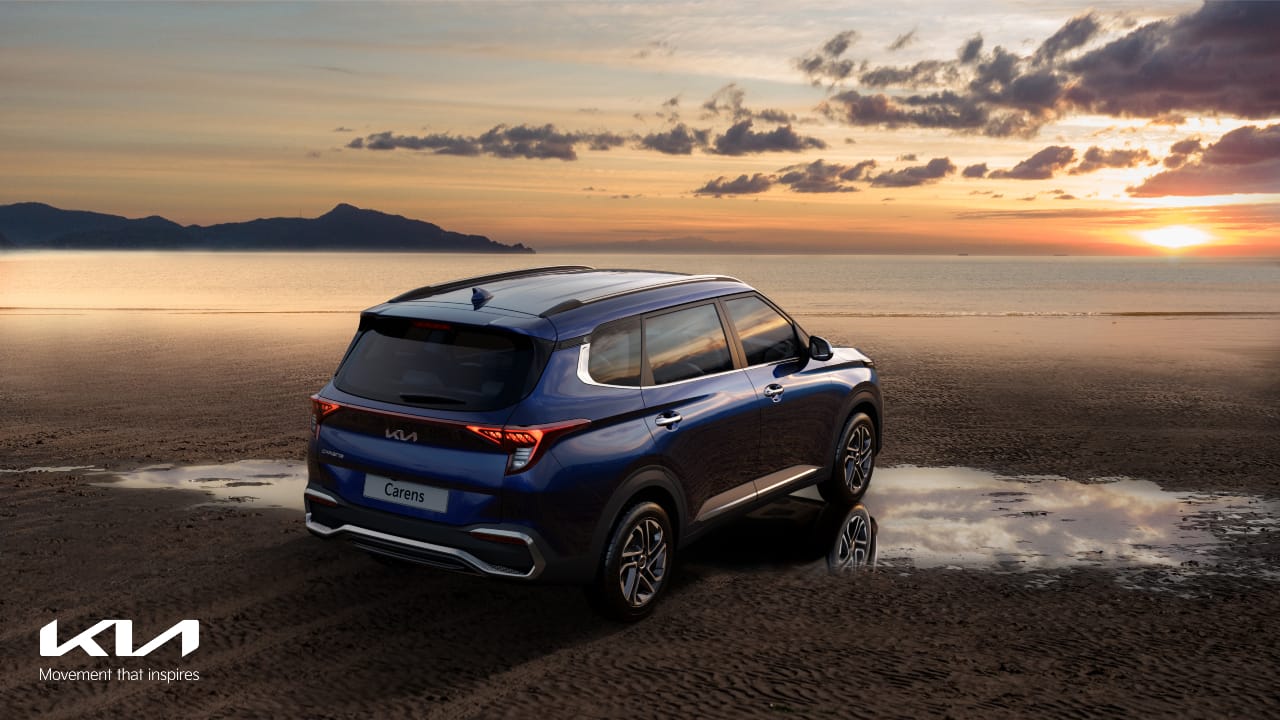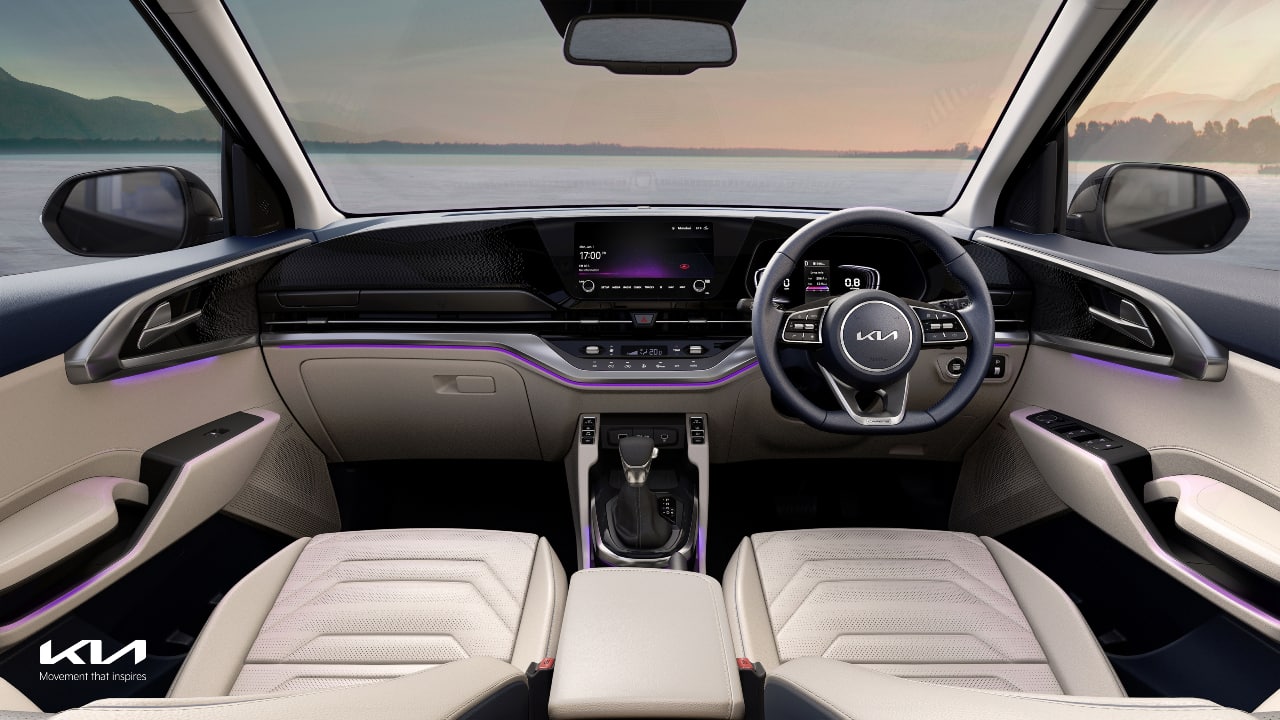



The Kia Carens is a three-row vehicle, and the primary reason for its existence is that third row of seat – so I’m going to begin this review from there.
The third row
In most three-row cars, the occupants of the last row have usually drawn the short straws and don’t travel in the greatest of comfort; that row is almost purely utilitarian (or for small children and animals).
The Carens, however – it gets the third row right. The seats are positioned just right, and the average Indian adult won’t feel cramped in there. The seats recline, which is great, and there are cup holders and USB charging. Shoulder and leg room are more than enough for two adults to stay comfortable over a relatively long drive.
The roof-mounted A/C vents are an excellent addition and go a long way towards keeping all the occupants nice and cool; in this respect, the lack of a panoramic sunroof is a more than acceptable tradeoff.
The competition
All right, on to the rest of the review. The Carens is Kia’s latest car, and it’s what it likes to call a ‘recreational vehicle’, which is marketing speak for ‘people carrier’. What Hyundai did to the Creta to produce the Alcazar, Kia has more or less done to the Seltos to make the Carens, and this segment currently only has the aforementioned cars and the Maruti XL6 (other 6 and 7-seaters are either more expensive or cheaper).
Also read: Kia Carens Vs Hyundai Alcazar. A comparison of specs
The exterior
The Carens’ exterior is one of those love-it-or-hate-it designs; you certainly can’t ignore it. Unlike the Alcazar, which looks very similar to the Creta, the Carens has moved well away from the Seltos’ exterior design and is a completely fresh one in its own right.
Kia’s signature ‘tiger-nose’ grille has been worked on, and what you now get is a big, chrome-filled rectangular face with the headlights set down low and some gentle creases on the hood.
From the side, it can’t be mistaken for anything but an MPV; the overhangs at either end give the game away, but the flared wheel arches look good, and the alloys are attractive as well.
At the back, the tail lamps stand out, and there’s lashings of chrome here as well (we Indians just love that shiny stuff) – and a rear spoiler.
Personally, I grew fond of the design as I drove the Carens, and although I wouldn't call it groundbreaking, it’s certainly different enough to stand out on the road.
 The tail lights stand out, with lashings of chrome here as well. (Photo via autofutures.tv)
The tail lights stand out, with lashings of chrome here as well. (Photo via autofutures.tv)
The engine
Engine-wise, the Carens has three options – a 1.5-litre naturally aspirated petrol, a 1.4-litre turbo-petrol and a 1.5-litre diesel; I drove the latter two.
Unsurprisingly, the 1.4-litre turbo-petrol is the one to get if you want some oomph from your powerplant; it makes 138 bhp and 242 Nm of torque, and comes mated to either a 6-speed manual or a 7-speed dual-clutch automatic gearbox (the automatic versions get paddle-shifters as well). The engine is very refined and silent, and there’s plenty of driveability through the rev range, with a stomp on the accelerator producing appreciable forward progress in almost any gear. This is a very useable engine, and offers enough for most kinds of drivers. The manual gearbox has crisp throws, and the automatic keeps the engine in the correct rev range in an efficient way; the paddle shifters do add a touch of sportiness to the proceedings. Three drive modes are available – Eco, Normal and Sport, each altering the manner in which the throttle responds.
The 1.5-litre diesel is more of a workhorse. It makes 115 bhp and 250 Nm of torque, and at first might seem like it’s not up to the task of pulling along a car with seven people; in reality, it performs without any real issues. In most driving scenarios, you won’t feel a lack of power, and the gearboxes here are extremely smooth as well; getting up to a nice cruising speed of 120 kmph is easily accomplished, with the engine barely ticking over. The diesel only feels a bit gruff if you fully load up the car and want some especially brisk acceleration, or if you want to make rapid progress up a series of slopes. Sport mode and the paddle shifters do help in these conditions, though. The diesel will also be more fuel-efficient than the petrol, which would make it a good choice if you drive long distances often.
Ride quality
The ride quality is really rather good, I have to say – better than I expected anyway. It’s a touch on the softer side, but it absorbs everything that the road throws at the car, and it’s only the occupants of the last row that will get a little bounced around over bad stretches – but that’s pretty standard with most seven-seaters. There is also a certain amount of road noise seeping into the cabin over broken stretches, but again, that’s not a deal-breaker.
The Carens is a very easy vehicle to drive despite its size. The steering feel is light (too light for my liking but perfect for most drivers), and goes from lock to lock in just over three turns; it weighs up as speeds increase. This car wasn’t built with sporting aspirations, so you shouldn't expect it to go around corners like a hound after a hare – there is evident body roll, but it’s not the kind that will throw the car off its line and is perfectly manageable. In any case, with a full load of passengers, it’s probably best not to act like an F1 driver; your cabin mates are almost certain to curse you. There are disc brakes all round, which is big plus.
The interiors
You can order your Carens either in six-seat or a seven-seat format; the former has two captain seats in the second row, the latter a 60:40 split-folding bench.
The cabin itself is a great place to be in; everything looks premium and high-quality and it’s bright and airy, much like the Seltos (with which the cabin shares some parts).
The Seltos’s twin-pod dual-screen instrument layout has been swapped out with a digital instrument cluster and a bezel-less 10.25-inch display for the infotainment system. There’s chrome inserts on various parts as well as lots of glossy black elements (which will be a pain to keep clean, as they’re fingerprint magnets).
 The Carens has a digital instrument cluster and bezel-less 10.25-inch display for the infotainment system.
The Carens has a digital instrument cluster and bezel-less 10.25-inch display for the infotainment system.
The seats
The front seats are very comfortable, although there is no powered driver’s seat even in the top-spec Carens, which is a shame; the front seats do get ventilation, however.
The second row of captain seats is excellent – comfortable, roomy and easy to get into and out of. Passengers here also get roof-mounted A/C vents, an air purifier (somewhat curiously mounted on the back of the driver’s seat, and also somewhat noisy), a tray table on the left and two USB-C charging ports. The seven-seat version is compromised in terms of space and comfort, as you would expect. The middle passenger won’t feel too pleased about sitting there for long, and the padding for the middle section is inferior as well. This section can be folded down to become an armrest with two cup holders, in case there are only two people in the second row.
In both seat layouts, the kerbside seat has a dedicated button for a one-touch tumble function, which makes access to the third row a real breeze; I’ve already sung the third row’s praises, so I won’t repeat myself.
The boot
Importantly, the boot is very spacious – even with the third row up, you get 216 litres of space. Fold the third row down and that goes up to 645 litres, and if you feel like shifting the contents of a small flat, the second row can be folded to create a whopping 1164 litres of cargo space; the high roof line helps to stuff more things in there.
The features
The top-spec Carens is loaded to the gills with features, but again, you were expecting that. On the outside, there’s diamond-cut 16-inch alloys, lots of chrome, full LED lighting and roof rails.
The cabin has, among many others: a 10.25-inch display with Kia’s new infotainment system, which has a new interface, a fully digital instrument cluster, buttons and switches on the steering wheel, ambient lighting, climate control with second and third-row A/C vents, connected car tech, a reversing camera (but no 360-degree camera), faux leather seats, a very good 8-speaker Bose audio system, rain-sensing wipers and power mirrors.
The fact that Kia has made six airbags, ABS with EBD (anti-lock braking system with electronic brakeforce distribution), rear parking sensors, a tyre-pressure monitoring system and ISOFIX mounting points (for child safety seats) for the second row standard across all variants is brilliant.

So, the important question – is the Kia Carens a car that I would recommend? Unhesitatingly so. It’s a compelling package – safety and other features, seating comfort in the third row (and the other rows), quirky looks, ride quality, practicality and excellent engines. At an expected price range of between Rs 14 lakh and Rs 19 lakh (ex-showroom), it will likely undercut the Hyundai Alcazar, which would be a smart move by Kia. The Korean firm has made a habit of launching top-selling cars in India, and I see no reason for the Carens not to join that lineup.
Discover the latest Business News, Sensex, and Nifty updates. Obtain Personal Finance insights, tax queries, and expert opinions on Moneycontrol or download the Moneycontrol App to stay updated!